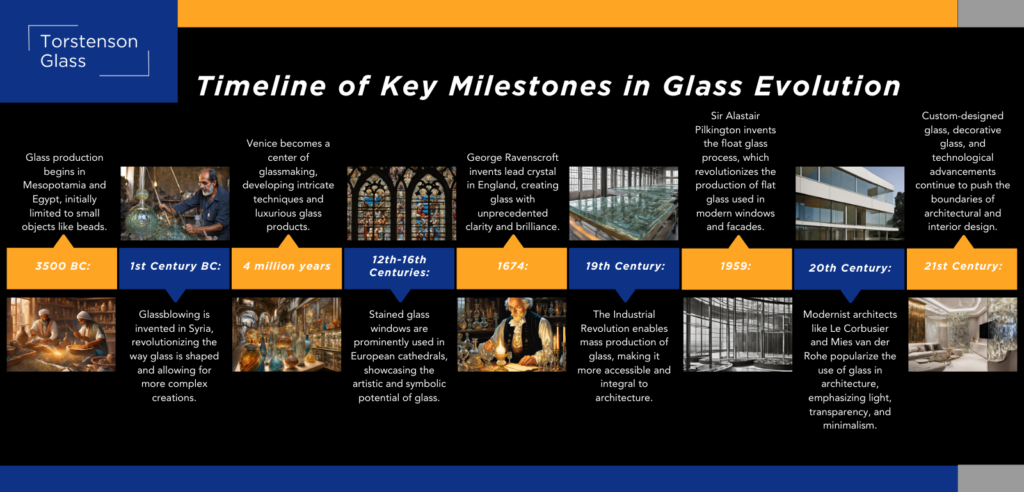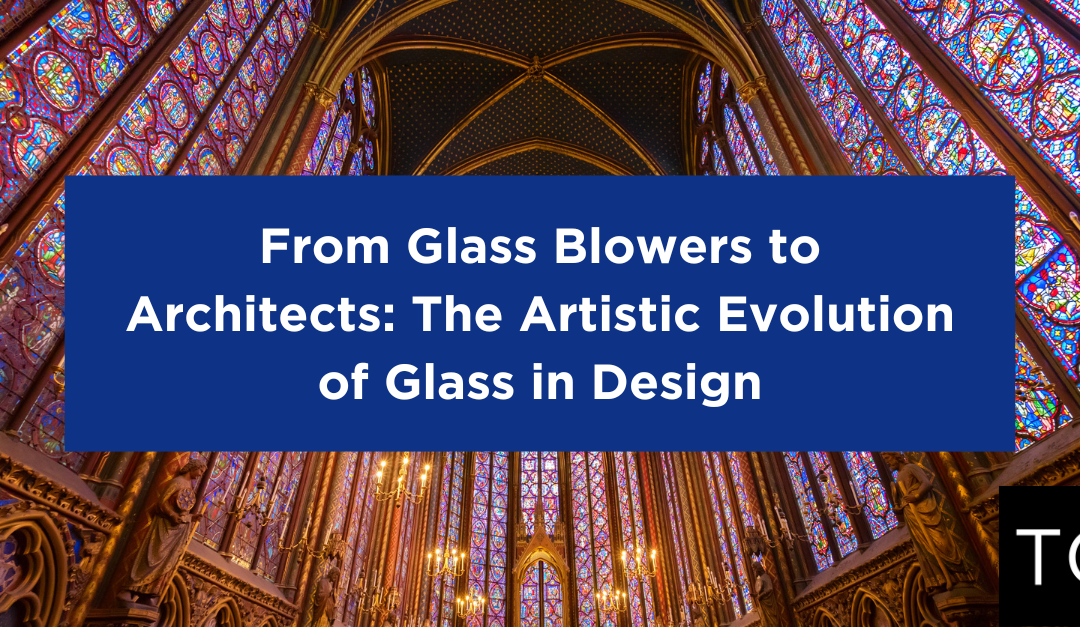For millennia, glass has been a material of both practical utility and artistic wonder. Its versatility has made it a staple in everything from delicate vessels to modern skyscrapers, evolving over time as a key part of the evolution of glass in design. From the hands of ancient glass blowers to the desks of contemporary architects, glass has played a transformative role in shaping how we experience our surroundings. Today, it is much more than a functional element—it is a powerful design tool that merges art and innovation.
The Early Days of Glass: Craftsmanship and Artistry
The story of glass begins over 5,000 years ago in Mesopotamia and Egypt, where the first glass objects, primarily small beads and vessels, were created. It wasn’t until the 1st century BC, however, that the invention of glassblowing revolutionized glassmaking. This technique, originating in Syria, allowed artisans to create more intricate and complex glass forms, making it a coveted material for luxury items and works of art.

In medieval Europe, stained glass became one of the most celebrated forms of artistic glasswork, particularly in cathedrals and palaces. These colorful windows were not only decorative but also rich with symbolism, turning light into a medium of storytelling. The craftsmanship of these early glassmakers laid the foundation for glass’s eventual role in architectural design, setting the stage for future innovations.
Timeline of Key Milestones in Glass Evolution

- 3500 BC: Glass production begins in Mesopotamia and Egypt, initially limited to small objects like beads.
- 1st Century BC: Glassblowing is invented in Syria, revolutionizing the way glass is shaped and allowing for more complex creations.
- 9th Century AD: Venice becomes a center of glassmaking, developing intricate techniques and luxurious glass products.
- 12th-16th Centuries: Stained glass windows are prominently used in European cathedrals, showcasing the artistic and symbolic potential of glass.
- 1674: George Ravenscroft invents lead crystal in England, creating glass with unprecedented clarity and brilliance.
- 19th Century: The Industrial Revolution enables mass production of glass, making it more accessible and integral to architecture.
- 1959: Sir Alastair Pilkington invents the float glass process, which revolutionizes the production of flat glass used in modern windows and facades.
- 20th Century: Modernist architects like Le Corbusier and Mies van der Rohe popularize the use of glass in architecture, emphasizing light, transparency, and minimalism.
- 21st Century: Custom-designed glass, decorative glass, and technological advancements continue to push the boundaries of architectural and interior design.
The Industrial Revolution: Glass Becomes Accessible
The Industrial Revolution of the 18th and 19th centuries marked a turning point in the evolution of glass in design. New production techniques, such as the development of plate glass and the float glass process, made it possible to manufacture large, smooth sheets of glass that were not only affordable but also ideal for building purposes. As a result, glass began to feature prominently in homes, public buildings, and eventually skyscrapers.

This new accessibility transformed glass from a luxury item into a fundamental material in construction. Suddenly, the potential for large windows, expansive facades, and open, airy interiors was within reach. Architects quickly recognized the design possibilities, and glass moved from small decorative windows to becoming the centerpiece of entire buildings.
Modernism and Beyond: Glass as a Design Staple
The 20th century brought about a major shift in the way architects viewed glass. No longer confined to small panes or purely decorative elements, glass became an essential material in modern architecture. Pioneers like Ludwig Mies van der Rohe and Le Corbusier championed the use of glass for its transparency and its ability to connect interior and exterior spaces seamlessly. Their designs used large expanses of glass to emphasize light, minimalism, and a sense of openness.
Glass was no longer just functional—it became an expression of modernist ideals. The reflective surfaces of skyscrapers and the open, flowing spaces of glass-walled homes were emblematic of progress and modernity. This era cemented glass’s role as a critical element of architectural design, and it hasn’t looked back since.
The Future of Glass in Design: A Canvas for Innovation
In the 21st century, glass continues to evolve. Architects and designers are constantly pushing the boundaries of what glass can do, using it to create visually stunning spaces that are both functional and artistic. Custom glass options, like etched, frosted, and back-painted glass, offer endless possibilities for personalized, creative designs.
At Torstenson Glass, we’re proud to be at the forefront of this evolution. Our custom glass solutions blend craftsmanship with modern innovation. Whether used to create bold facades or intricate interior details, glass continues to be a versatile and inspiring medium for design.
As innovations in glass technology continue, designers will find even more ways to harness the beauty and functionality of glass. From artistic installations to custom-built architectural features, glass remains a crucial component in shaping the spaces of tomorrow.
Conclusion: Glass—An Ever-Evolving Art Form
From the hands of ancient glassblowers to the minds of today’s leading architects, the evolution of glass in design showcases its journey as both a functional material and a work of art. It remains a key player in shaping how we experience light, space, and beauty in the modern world.
At Torstenson Glass, we are committed to honoring this tradition while embracing the future. As the use of glass continues to evolve, so too does its capacity to inspire. Whether for custom facades or intricate interior details, glass remains a canvas for endless creativity and innovation, offering architects and designers limitless possibilities for the spaces of tomorrow.
